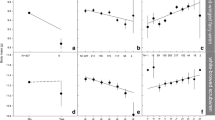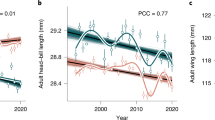Abstract
Climatic conditions may impact on the body condition of animals and thereby affect their survival prospects. However, climate may also impact directly on the survival prospects of animals by affecting the size of immune defence organs that are used for defence against parasites. We used a large long-term database on body condition and size of the spleen in birds to test for immediate and delayed relationships between climatic conditions as indexed by the North Atlantic Oscillation (NAO) and body condition and spleen mass, respectively. Across 14 species of birds, spleen mass was significantly positively correlated with the NAO index, while the delayed effect of NAO on spleen mass was not significant. Spleen mass was positively related to body condition, but body condition did not depend significantly on NAO or delayed NAO effects. Bird species with a strong positive effect of NAO on spleen mass tended to have small spleens for their body size, while species with a strong negative effect of NAO on spleen mass tended to have relatively large spleens. Since bird species with relatively large spleen have been shown to suffer more from the negative effects of parasites, we can infer that the effects of climate as indexed by NAO on the size of the spleen depends on the importance of parasite-mediated natural selection.

Similar content being viewed by others
References
Alberts B, Lewis J, Ratt M, Roberts K, Watson JD (eds) (1983) Molecular biology of the cell. Garland, New York
Allander K (1998) The effects of an ectoparasite on reproductive success in the great tit: a 3-year experimental study. Can J Zool 76:19–25
Alonso-Alvarez C, Tella JL (2001) Effects of experimental food restriction and body-mass changes on avian T-cell mediated immune response. Can J Zool 79:101–105
Arnqvist G, Wooster D (1995) Meta-analysis: synthesizing research findings in ecology and evolution. Trends Ecol Evol 10:236–240
Arvy L (1965) Splénologie. Gauthiers-Villars, Paris
Both C, Visser ME (2001) Adjustment to climate change is constrained by arrival date in a long-distance migrant bird. Nature 411:296–298
Brown ME (1997) Assessing body condition. In: Nolan V, Ketterson ED (eds) Current ornithology, vol 13. Plenum, New York, pp 67-135
Chandra RK, Newberne PM (1977) Nutrition, immunity, and infection. Plenum, New York
Gershwin ME, Beach RS, Hurley LS (1985) Nutrition and immunity. Academic Press, Orlando, Fla.
Hurrell JW (1995) Decadal trends in the North Atlantic Oscillation: Regional temperatures and precipitation. Science 269:676–679
John J (1994) The avian spleen: a neglected organ. Q Rev Biol 69:327–351
Kareiva PM, Kingsolver JG, Huey RB (1993) Biotic interactions and global change. Sinauer, Sunderland, Mass.
Keymer IF (1982) Parasitic diseases. In: Petrak ML (ed) Diseases in cage and aviary birds. Lea and Febiger, Philadelphia, pp 535–598
Lope F de, González G, Pérez JJ, Møller AP (1993) Increased detrimental effects of ectoparasites on their bird hosts during adverse environmental conditions. Oecologia 95:234–240
Møller AP (2002) North Atlantic Oscillation (NAO) effects of climate on the relative importance of first and second clutches in a migratory passerine birds. J Anim Ecol 71:201–210
Møller AP, Erritzøe J (2000) Predation against birds with low immunocompetence. Oecologia 122:500–504
Møller AP, Erritzøe J (2002) Coevolution of host immune defence and parasite-mediated mortality: relative spleen size and mortality in altricial birds. Oikos 99:95–100
Møller AP, Jennions MD (2001) Testing and adjusting for publication bias. Trends Ecol Evol 16:580–586
Møller AP, Jennions MD (2002) How much variance can be explained by ecologists and evolutionary biologists? Oecologia 132:492–500
Møller AP, Thornhill R (1998) Male parental care, differential parental investment by females, and sexual selection. Anim Behav 55:1507–1515
Møller AP, Christe P, Erritzøe J, Mavarez J (1998) Condition, disease and immune defence. Oikos 83:301–306
Møller, AP, Erritzøe J, Saino N (2003) Seasonal changes in immune response and parasite impact on hosts. Am Nat 161:657–671
Molyneux DH, Cooper JE, Smith WJ (1983) Studies on the pathology of an avian trypanosome T. bouffardi. Infection in experimentally infected canaries. Parasitology 87:49–54
Morand S, Poulin R (2000) Nematode parasite species richness and the evolution of spleen size in birds. Can J Zool 78:1356–1360
Mouritsen KN, Poulin R (2002) Parasitism, climate oscillations and the structure of natural communities. Oikos 97:462–468
Parmesan C, Ryrholm N, Stefanescu C, Hill JK, Thomas D, Descimon H, Huntley B, Kaila L, Kullberg J, Tammaru T, Tennent WJ, Thomas JA, Warren M (1999) Poleward shifts in geographical ranges of butterfly species associated with regional warming. Nature 399:579–583
Poulin R (1998) Evolutionary ecology of parasites. Chapman and Hall, London
Rose ME (1981) Lymphatic system. In: King AS, McLelland J (eds) Form and function in birds, vol 2. Academic Press, London, pp 341–384
Saether B-E, Tufto J, Engen S, Jerstad K, Røstad OW, Skåtan JE (2000) Population dynamical consequences of climate change for a small temperate songbird. Science 287:854–856
Shutler D, Alisauskas RT, McLaughlin JD (1999) Mass dynamics of the spleen and other organs in geese: measures of immune relationships to helminths? Can J Zool 77:351–359
Sillett TS, Holmes RT, Sherry TW (2000) Impacts of global climate cycle on population dynamics of a migratory songbird. Science 288:2040–2042
Toivanen P, Toivanen A (eds) (1987) Avian immunology. CRC Press, Boca Raton, Fla.
Acknowledgement
This study benefited from comments and discussion by N. Saino
Author information
Authors and Affiliations
Corresponding author
Appendix
Appendix
Table 3 shows summary statistics of spleen and body mass and associated correlations
Rights and permissions
About this article
Cite this article
Møller, A.P., Erritzøe, J. Climate, body condition and spleen size in birds. Oecologia 137, 621–626 (2003). https://doi.org/10.1007/s00442-003-1378-1
Received:
Accepted:
Published:
Issue Date:
DOI: https://doi.org/10.1007/s00442-003-1378-1




